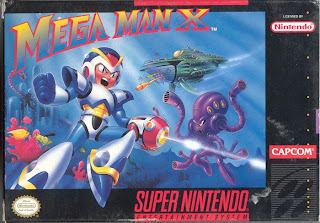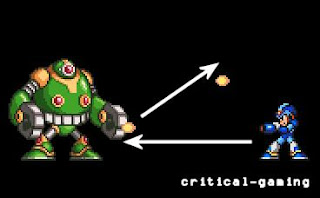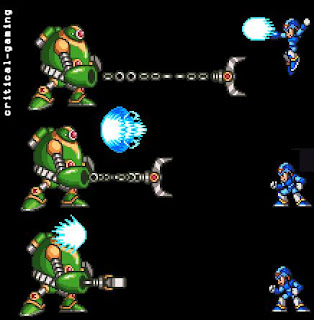

In Mega Man X, there are 4 different types of shots with 3 levels of charge. The standard shot is very small. All damage is quantified by this attack. Though each bullet only does 1 unit of damage, this shot can be fired about as rapidly as the player can push the fire button (faster than 13 shots per second). This attack is only limited by the player speed and how the game is limited to displaying 3 shots of any type on the screen at any one time.
The green shot does 2 units of damage and travels at the same speed as the standard shot. To charge, players must hold down the fire button for approximately .6 seconds and release.
The blue shot does 4 units of damage and travels slightly faster than all other shots. It takes approximately 2 seconds to charge.
The pink charge is a devastating attack. By doing 12 units of damage from a 3.5 second charge, for the additional charge time, this attack triples the damage and the range of the blue charge shot.
In my experience, I use every type of charge in the game. Unlike other games where the most powerful attack strategy is used in every situation to efficiently progress (RPGs - attack-attack-heal), the 4 levels of shots in Mega Man X are balanced by time and space. The rapid standard shot is most effective at close range and on stationary targets. The green and blue charge shots are effective on most targets, but the player must sacrifice time to build each charge. However, because shooting and moving are directly related (ie. Mega Man can only shoot in the direction he's facing) there will naturally be times where the standard shot would be completely ineffective as the player is dodging, getting into position, or aiming.
Because the blue charge shot is slightly faster than the standard shot, it's possible for the player to hit targets that the standard shot would not be fast enough to reach. And finally, the pink charge shot takes the longest to charge but does the most damage of any single shot. Though this attack is large and travels at the same speed as the standard shot, it takes the longest to active upon releasing the fire button. This slightly changes the timing needed for aiming unlike all the other shot attacks. Using the pink charge shot involves the most risk-reward out of all of the shot attacks. As the charge time increases, the pressure on aiming increases. After all, in the world of gunplay, victory and death are both either hit or miss.




Look at this green enemy for example. As you can see, all shots are ineffective on all spots except its head. The only way to hit the head is by repeatedly jumping and shooting. Because the enemy claw attacks is so predictable and avoidable by jumping, the advantages gained by charging are diminished. In other words, the time it takes to charge and fire just about equals the damage players can inflict by repeatedly jumping and firing standard shots. Because this enemy has so much health, and the strategy doesn't change even when the battle speed increases, this battle contains a lot of negative space.

For most bosses and enemies, the increased range and damage from charge shots offers strategic alternatives to the player's offensive approach. Due to Mega Man's solid platforming elements, dodging attacks, jumping over enemies, and moving through the environment naturally creates opportunities where it is advantageous for the player to start charging. In the image above, when Mega Man jumps over the missile or the electric balls, the enemy is ducking too low for a standard shot to hit. In this situation, charging a shot turns the negative space where the player would have to wait into positive space by investing in the next attack opportunity. So, as the the player moves through ever changing situations, the advantages and difficulty of the different shot strategies changes dynamically.
MegaMan is just one game series that has nailed the CHARGE mechanic. Let's look at some others.
- The Legend of Zelda Series: spin attack. By holding down the attack button, players can hold out their sword for a powerful 360 degree spin attack. While holding the charge, player mobility is limited to facing in one direction. Though the outstretched sword is an attack, if it hits anything the charge is lost. Also many attacks can be held and charged for additional speed/damage/effects.
- Team Fortress 2 sniper class: By saying in scope, the sniper shot slowly charges to maximum damage. When the player drops the scope view, the charge is lost. This mechanic helps keep snipers playing like snipers (ie. long range shooters with careful, patient positioning).
- Super Mario Strikers Charged: Skill Shots. The non-captain characters all have a special skill shot they can make on the goalie if they charge the ball long enough. Some charges are quick, but don't have high scoring abilities. Some charges are long with nearly guaranteed goals as certain ranges. You can tell when a character is charging because they have to stop moving to charge. When the blue energy comes out, the charge is nearly complete. In addition to skill shots, the captains can charge mega strikes for multiple goals. And chip shots can be charged as well.
- Super Smash Brothers Series: All smash attacks can be charged to increase their damage and knock back. Additionally, there are many projectiles and special moves that can be charged including Giant's Punch, Needle Storm, Spin Charge, Peanut Popgun, and of course the Wario Waft.
- Halo 3: Spartan Laser. This powerful gun is strong enough to destroy ground based vehicles and flying crafts in one blast not to mention completely eliminating human players. To activate, players much charge the shot. While charging, a warning laser is sent out of the gun to tell targets that they're in a danger zone.
- Final Fantasy Crystal Chronicles. Players can charge their melee attacks and magical spells. After charging, a cursor will appear indicating where the attack will land. If multiple players line up their cursors and time the release of their charges, new combination attacks are made. The cursor system is similar to the warning laser in Halo 3. It shows the intent of a player visually on screen so others can react appropriately. In this case, the possible reactions are for cooperative attacks.
- Star Fox 64. Homing shot. By charging the laser attack, players gain a slower projectile that can home in on targets and explode in a powerful blast.
- Super Mario Bros. 2: Players can charge their jumps by holding down.
- Super Mario Bros. 3/Super Mario World: Players can charge their run by running for an extended period of time. Once at max speed, with the aid of specific powerups, Mario can take off and fly around.


No comments:
Post a Comment